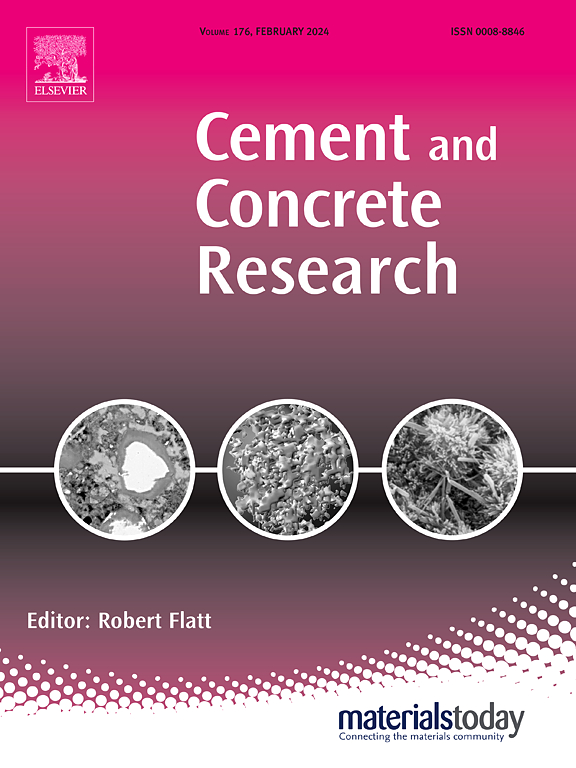Low-grade kaolinitic clays as SCMs for low-carbon cements and strength improvement by C-S-H gel nucleation seeding
IF 13.1
1区 工程技术
Q1 CONSTRUCTION & BUILDING TECHNOLOGY
引用次数: 0
Abstract
This study seeks to push the limits of LC3-50 binders by utilising low-grade kaolinite clays and C-S-H gel nucleation seeding. Four commercially-available kaolinite clays (i.e. kaolinite contents ~20 wt%) have been studied by X-ray fluorescence, X-ray powder diffraction and thermal analysis. The clays were thermally activated and milled to Dv,50 = 11 ± 2 μm. The activated clays showed low pozzolanic performances, as determined by ASTM C1897-20 standard. The heat flows ranged 200–230 J/g calcined clay and the bound waters 4.3–5.7 %. The LC3-50 pastes were characterised by calorimetry, X-ray powder diffraction and the Rietveld method, thermal analysis, and porosimetry to evaluate pozzolanic reactivity and the seeding effect.
LC3 mortars, w/b = 0.40, have relatively low compressive strengths, especially at one day, but these values were increased by 64 % on average at one day by seeding. At 1 day, three LC3 mortars showed 11 MPa which increased to 18–20 MPa by seeding. A fourth mortar showed a much higher compressive strength, 16 MPa, that increased to 23 MPa, by seeding. A tested concrete, w/b = 0.50, also showed a high increase of 37 % at 1 day. The improvements at 28 days were maintained but quantitatively lower, 12 and 14 % for the mortars and the concrete, respectively. Insights into the pozzolanic reactions and C-S-H seeding are obtained from the quantitative study of the pastes. For instance, it is proven the pozzolanic reaction at 1 day from the portlandite consumption. Also shown is the enhanced formation of carboaluminates when the strength enhancing admixture is added.
低品位高岭石粘土作为低碳胶结剂和C-S-H凝胶成核播种提高强度的SCMs
本研究试图通过利用低品位高岭石粘土和C-S-H凝胶成核种子来突破LC3-50粘合剂的极限。用x射线荧光、x射线粉末衍射和热分析对四种市售高岭石粘土(即高岭石含量~20 wt%)进行了研究。热活化后的粘土被磨成Dv,50 = 11±2 μm。经ASTM C1897-20标准测定,活性粘土具有较低的火山灰性能。煅烧粘土热流为200 ~ 230 J/g,束缚水热流为4.3 ~ 5.7%。采用量热法、x射线粉末衍射法、Rietveld法、热分析和孔隙率法对LC3-50膏体进行表征,评价其反应性和播种效果。当w/b = 0.40时,LC3砂浆的抗压强度相对较低,特别是在一天内,但通过播种,这些数值平均提高了64%。在第1天,3个LC3砂浆为11 MPa,播种后增加到18-20 MPa。第四种砂浆表现出更高的抗压强度,从16 MPa增加到23 MPa。一种w/b = 0.50的测试混凝土在1天内也显示出37%的高增长。28天的改善保持不变,但在数量上有所下降,砂浆和混凝土分别为12%和14%。从膏体的定量研究中获得了对火山灰反应和C-S-H播种的见解。例如,它证明了在波特兰消耗后1天的火山灰反应。同时还显示了当加入强度增强外加剂时碳铝酸盐的增强形成。
本文章由计算机程序翻译,如有差异,请以英文原文为准。
求助全文
约1分钟内获得全文
求助全文
来源期刊

Cement and Concrete Research
工程技术-材料科学:综合
CiteScore
20.90
自引率
12.30%
发文量
318
审稿时长
53 days
期刊介绍:
Cement and Concrete Research is dedicated to publishing top-notch research on the materials science and engineering of cement, cement composites, mortars, concrete, and related materials incorporating cement or other mineral binders. The journal prioritizes reporting significant findings in research on the properties and performance of cementitious materials. It also covers novel experimental techniques, the latest analytical and modeling methods, examination and diagnosis of actual cement and concrete structures, and the exploration of potential improvements in materials.
 求助内容:
求助内容: 应助结果提醒方式:
应助结果提醒方式:


